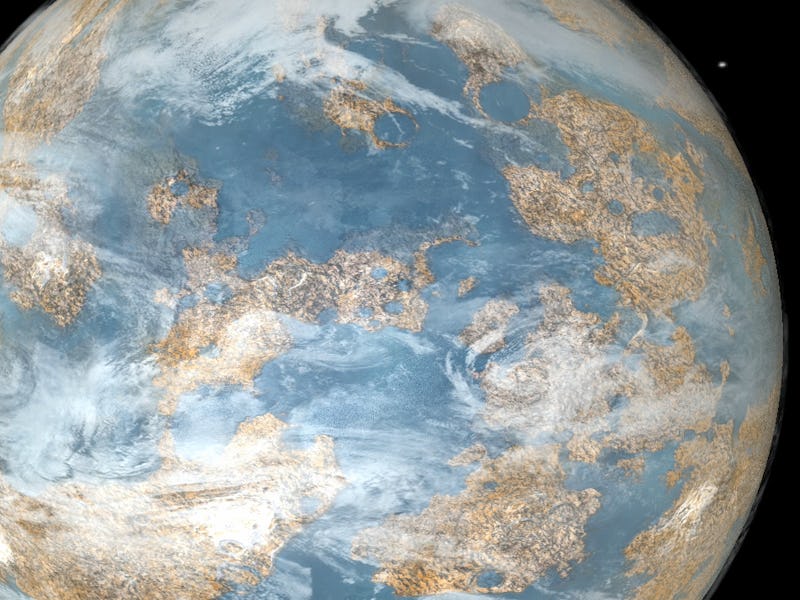One of the most common criticisms about the search for life is that scientists spend too much time looking for Earth-like life. Why is that the case? Doesn’t this kind of narrow focus simply limit us from actually finding anything?
Two researchers spent Monday tackling that question during “Searching for Life Across Space and Time,” the first of a two-day workshop about aliens hosted by the National Academies of Sciences, Engineering, and Medicine.
John Baross of the University of Washington and Tori Hoehler from NASA Ames Research Center, made the trip to Irvine, California to discuss theories behind what scientists should focus on when searching for extraterrestrial life on other worlds — and the two unintentionally laid out a pretty good case for why those efforts should focus on Earth-like life.
From the outset, we know that scientists focus on aliens resembling life from Earth because all any of us know is Earth. Looking for something that’s totally unknown is, to put it lightly, pretty damn difficult. If Earth-like life sprung up once, it could do so again.
What does “life resembling Earth life” mean? According to Baross, there are three broad requirements: It needs to be carbon-based, it must require liquid water, and it must use light- or chemical-based energy.
That’s actually not as limiting as we might think. Sure, it means the odds of finding life on a cold gas planet like Neptune or a barren atmosphere-less rock, like the moon, are next to impossible. But there are plenty of reasons to believe life can survive on other worlds.
Baross summarizes the requirements of Earth-like life on other worlds down to what he terms “CHONPS + Fe”: carbon, hydrogen, oxygen, nitrogen, phosphorus, sulfur, and iron. And he emphasizes, “life requires trace elements.” A planet does not necessarily need to be stocked with huge troves of these elements in order to encourage life.
But that depends on how you view the origin of life. Baross thinks in order to think about how species could evolve and make a home for themselves on another planet, we need to first consider how that life could get there. Would it have to evolve de novo — coming together on the planet itself, undergoing the series of biochemical steps that turns organic matter into self-sustaining and reproducing life? Or could it perhaps just arrive via panspermia — the idea that life can hitch a ride on asteroids or comets, survive the journey through deep space, and colonize other worlds?
The implications are twofold. First, life that gets around through panspermia would probably be able to survive without requiring vast reserves of minerals and elements he outlines as required for life. Geothermal and tectonic processes, he thinks, are fundamental for life, but panspermia might mean life doesn’t need a planet as internally active and hot as Earth. On the other hand, “I think you need a helluva lot more [resources] to get a de novo origin, said Baross. Geochemical processes would need a very active planet in order to lead to biogeochemical processes that lead to the evolution of life.
The other thing to consider is that we know life on Earth has a common ancestor. The diversity we see today branched out of a single unicellular species. If life can get around via panspermia, then it supports the notion we can find Earth-like organisms on other worlds. If de novo origin is more likely, we may not necessarily be hedging our bets well by looking for Earth-like life, since those worlds could possess species that evolved using vastly different resources and biological pathways.
The Echus Chasma, one of the largest water source regions on Mars, is pictured from ESA's Mars Express.
For Tori Hoehler, one of the keys to finding extraterrestrial life is to understand the limits of life on other planets. Earth is very unique for a couple of reasons: it has vast reserves of water, which is an incredibly necessary solvent for making the metabolic processes of cells run forward: and it’s the only system we know of in which light can flow directly into the liquid solvent, allowing organisms to directly access it for energy.
So Hoehler raises two important questions: “Is there any other possibility” besides using water as a solvent? And, “what if life didn’t have access to light energy?”
It’s so far unclear what alternatives to water could act as a solvent for life. And while chemical energy could play a role, not nearly enough energy could make it towards areas of the solvent that are optimal for life to evolve. On Earth, Hoehler’s estimates mean about 63-105 terawatts of energy derived from light hit the surface of the ocean. Meanwhile, only 0.006 terawatts of energy released by the Earth’s core and rerouted into chemical energy make it up to the surface of the ocean.
That huge difference is just one kind of limitation astrobiologists need to consider, but altogether, those limits clamp down on how much biomass can accrue, then how big the metabolic and biosynthetic rates can rise up to, and ultimately the capacity for life to evolve into complex forms.
Both Baross and Hoehler think their needs advocate a clearer framework for how scientists intend to translate these ideas into the observation of biosignatures that indicate the presence of life. “We have to detect multiple signatures,” said Baross, which need to be measured through multiple techniques.
Hoehler particularly emphasizes focusing “not on the ‘what,’ but on ‘how much.’” He means assessing life and habitability on other worlds will not simply be a binary process — it’s much more nuanced than that, and each new planet or moon we discover with the potential to sustain life must be evaluated on its own. “Life is not a ‘1’ or a ‘0’, he said.
